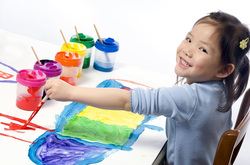
Teachers have a big job trying to fit everything into a lesson. Sometimes it seems like there’s just no way to include ‘extras’ like composition. Or you might feel that composition is un-teachable—a matter of talent alone. But composition doesn’t have to be ‘hard’ and it doesn’t have to take hours of lesson time. Teaching composition can be as simple as incorporating short activities and games which you build on over a period of weeks. Here’s one of my favorites. I call it ‘the copy-cat game.’
The Copy-Cat Game
One person is the “cat,” and the other person is the “copy-cat.” The cat makes up (composes!) a short, 4-5 note phrase and the copy-cat copies it. Ask the student whether they would like to start as the cat or the copy-cat. After a few turns you can switch roles. Young children love this game and it can be played from the very first lesson. You can begin, for example, with right hand alone in C Major 5-finger position with the copy-cat playing right hand in C position an octave below. A more advanced variation is for the cat to play a “question phrase” and the copy-cat to improvise an “answer.” Eventually the phrases can be written down and, in future lessons, a simple harmony introduced. Older students can work with longer phrases in different keys or in modal, whole tone, octatonic or other scales.
This is a wonderful pedagogical tool in other ways as well. I like to create patterns that force the student to play finger combinations that are a challenge for them, or to anticipate portions of melodies they will have to play in their next piece. I invite students to play this game with their right hand as the cat and left hand as the copy-cat and vice versa. Playing the same tune in each hand helps them develop independence of the hands as their brain adjusts to the fact that the same pattern of notes cannot be played with the same pattern of finger numbers in right and left hands. The Copy-Cat Game is just one fast, easy, fun way to incorporate composition into a regular lesson and demystify it for both student and teacher.
The Copy-Cat Game
One person is the “cat,” and the other person is the “copy-cat.” The cat makes up (composes!) a short, 4-5 note phrase and the copy-cat copies it. Ask the student whether they would like to start as the cat or the copy-cat. After a few turns you can switch roles. Young children love this game and it can be played from the very first lesson. You can begin, for example, with right hand alone in C Major 5-finger position with the copy-cat playing right hand in C position an octave below. A more advanced variation is for the cat to play a “question phrase” and the copy-cat to improvise an “answer.” Eventually the phrases can be written down and, in future lessons, a simple harmony introduced. Older students can work with longer phrases in different keys or in modal, whole tone, octatonic or other scales.
This is a wonderful pedagogical tool in other ways as well. I like to create patterns that force the student to play finger combinations that are a challenge for them, or to anticipate portions of melodies they will have to play in their next piece. I invite students to play this game with their right hand as the cat and left hand as the copy-cat and vice versa. Playing the same tune in each hand helps them develop independence of the hands as their brain adjusts to the fact that the same pattern of notes cannot be played with the same pattern of finger numbers in right and left hands. The Copy-Cat Game is just one fast, easy, fun way to incorporate composition into a regular lesson and demystify it for both student and teacher.

 RSS Feed
RSS Feed